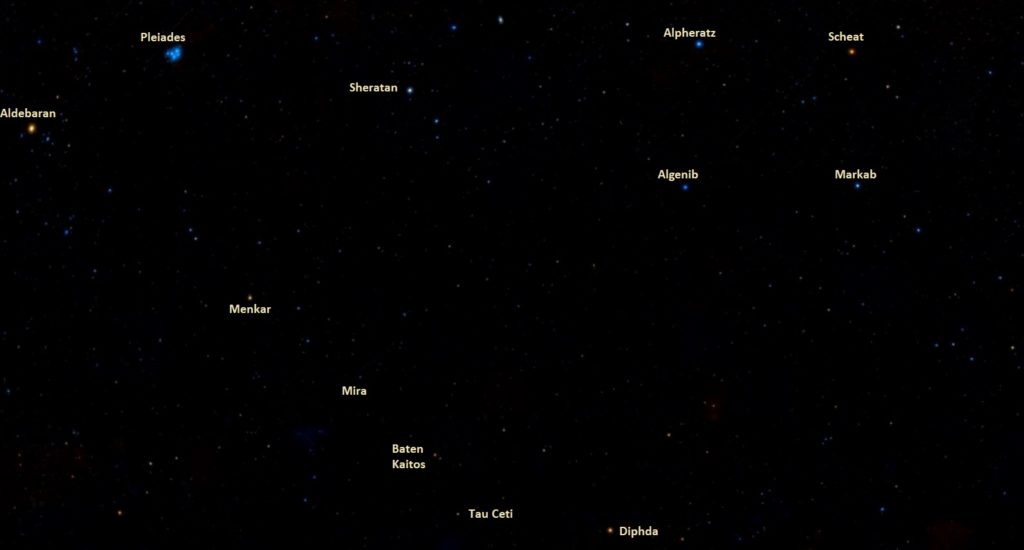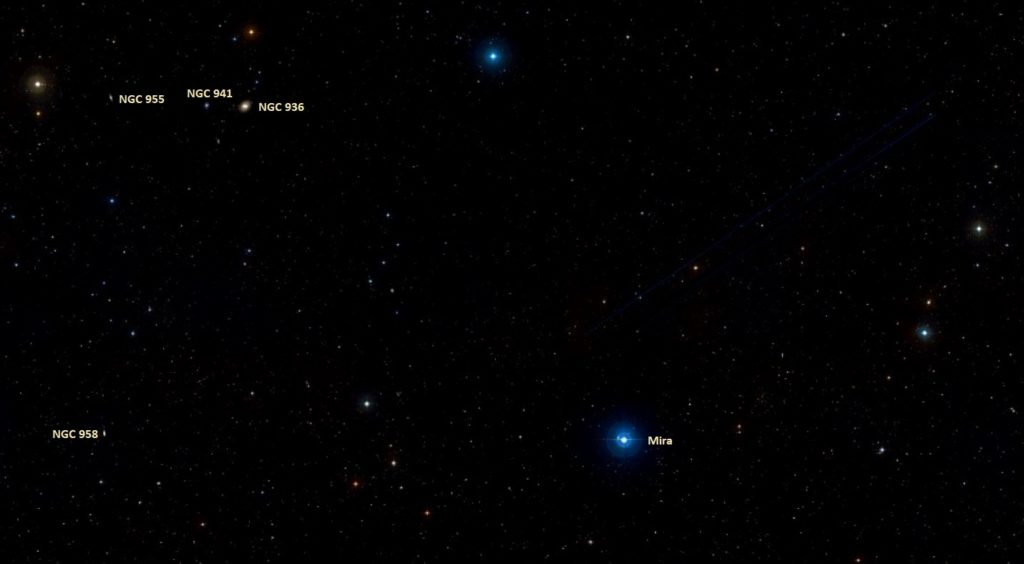Mira, Omicron Ceti (ο Cet), is an evolved red giant star located in the constellation Cetus. It is a pulsating variable that serves as a prototype for its own class of stars, known as the Mira variables. Mira has an apparent magnitude that varies from 2.0 to 10.1. It is part of a binary system that also contains a faint white dwarf (Mira B). The system lies at an approximate distance of 300 light years from Earth.
Star system
The Omicron Ceti system consists of the red giant Mira and a hot white dwarf, Omicron Ceti B (Mira B). The two stars form a symbiotic pair, the nearest one to the Sun. In 1995, the white dwarf was separated by 70 astronomical units from the primary. It orbits Mira with a period of 497.88 years. The system has an eccentricity of 0.16. The inclination is 112°, which means that we see the system almost edge-on.
Mira, the primary component, is in the late stages of its life and is losing mass. The material lost from the star is accreted by the white dwarf companion. Observations with the Chandra X-ray Observatory have revealed a bridge of matter flowing from the primary star to the companion. Mira is estimated to lose about a millionth of the Sun’s mass per year, or about one Earth mass every 10 years.
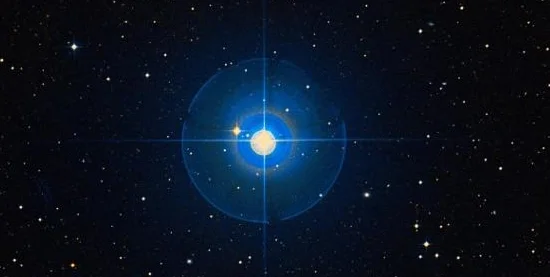
Mira (Omicron Ceti), image: Wikisky
Mira is a pulsating variable star whose brightness varies in the range from magnitude 2.0 to 10.1 over a period of 331.65 days. The pulsations cause the star to expand and contract and its spectral type, radius, luminosity and temperature all vary depending on the phase. The giant has the stellar classification M7 IIIe and its spectral class varies from M5 IIIe to M9 IIIe as it pulsates. The pulsations cause the star’s photosphere to expand by about 50% compared to a non-pulsating star. Modelling has shown that, without the pulsations, Mira would have a radius of about 240 solar radii.
As it is a pulsating star, Mira has a radius that changes from about 332 to 402 solar radii. (Some sources give a maximum radius as large as 541 solar radii.) Even though it is well over 300 times larger than the Sun, Mira has a mass of only 1.18 solar masses. The star’s luminosity changes from 8,400 to 9,360 times that of the Sun with a temperature in the range from 2,918 to 3,192 K. The estimated age of Mira is 6 billion years.
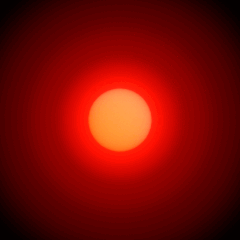
Mira animation, image: Wikimedia Commons/Merikanto (CC BY-SA 4.0)
The temperature of Mira is highest after the star has reached its brightest phase and lowest just before the faintest phase. The size of the star’s photosphere is smallest around the time the temperature is highest and the largest size is observed just before the temperature drops to its lowest. Mira is at its most luminous when it is smallest and hottest. This is also when its visual magnitude reaches the maximum.
Mira is on the asymptotic giant branch (AGB), which is a late period in the evolution of low-to-intermediate mass stars (with up to 9-10 solar masses). AGB stars are characterized by inert carbon-hydrogen cores, inner shells around the core where helium is being fused into carbon, outer shells where hydrogen is being fused into helium, and large envelopes of material that are similar in composition to main sequence stars. In the early AGB phase, helium burning in the inner shell is the main source of energy and the stars expand in size to become red giants again.
Once the helium shell runs out of fuel, the stars enter the thermally pulsing AGB phase, which is where Mira is now. At this stage, the energy comes from hydrogen fusion in a thin shell, which prevents the inner helium shell from fusing stably. However, the helium from the hydrogen shell burning keeps building up over periods of 10,000 to 100,000 years until the inner helium shell ignites, starting a helium shell flash. The peak luminosity of the flash is thousands of times the star’s total luminosity and produces an increase in the star’s visible brightness of a few tenths of a magnitude. The thermal pulses and brightness increase last for several hundred years but are not related to the changes in brightness that last for tens to hundreds of days and are typical for stars at this stage of evolution. The luminosity of the shell flash decreases over a few years and, as the star expands and cools, the hydrogen shell burning stops. It is reignited again when the helium shell fusion comes near the hydrogen shell.
In Mira, each thermal pulse lasts about 10,000 years. The pulses grow stronger with each cycle and destabilize the outer envelope, causing dramatic changes in the star’s size and luminosity over much shorter periods. The star’s shape has been known to change and be asymmetrical due to bright surface spots that change their shape over periods of 3 to 14 months.
The brightness of Mira increases to magnitude 3.5 on average, but some cycles take it up to as high as magnitude 2.0, making it the brightest star in Cetus. At other times, the observed maxima have been as low as magnitude 4.9. Recorded minima have stayed between magnitudes 8.6 and 10.1. The total change from absolute maximum to absolute minimum is 1,700 times, but these values have never been observed in the same cycle. The star’s light curve typically exhibits an increase over a period of about 100 days and then fades to minimum over a period twice as long. At times, the star can be invisible to the unaided eye for several years if it reaches its maximum brightness in the spring months, when it is too close to the Sun and cannot be seen from mid-northern latitudes. In 1779, its brightness came close to first magnitude and was almost equal to that of Aldebaran, the luminary of Taurus and the 14th brightest star in the sky. At the time, the star had a luminosity 1,100 times that of the Sun.
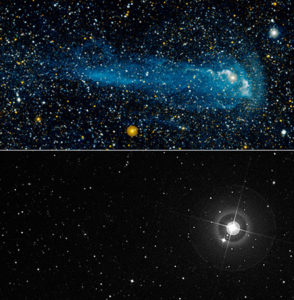
Mira in UV and visible light, image: NASA/JPL-Caltech/POSS-II/DSS/C. Martin (Caltech)/M. Seibert(OCIW)
Mira emits most of its energy output in infrared wavelengths. Its brightness varies in that band as well, but only by about two magnitudes.
The giant is not massive enough to end its life as a supernova. Instead, it will eventually cast off its outer envelope and gradually fade as a white dwarf. The expanding envelope will form a planetary nebula that will eventually disappear into the surrounding space.
Mira’s exact distance is uncertain. The currently accepted value of 299 light years is based on the 2007 Hipparcos reduction and has an 11% margin of error.
In 2007, images obtained with NASA’s Galaxy Evolution Explorer (GALEX) ultraviolet satellite revealed a bow shock and accompanying tail of material about 13 light years in length, or over 2 degrees on the sky. The tail has been formed over the past 30,000 years and interacted with interstellar dust in the star’s path.

A new ultraviolet mosaic from NASA’s Galaxy Evolution Explorer shows a speeding star that is leaving an enormous trail of “seeds” for new solar systems. The star, named Mira (pronounced my-rah) after the Latin word for “wonderful,” is shedding material that will be recycled into new stars, planets and possibly even life as it hurls through our galaxy. Mira appears as a small white dot in the bulb-shaped structure at right, and is moving from left to right in this view. The shed material can be seen in light blue. The dots in the picture are stars and distant galaxies. The large blue dot at left is a star that is closer to us than Mira. The Galaxy Evolution Explorer discovered Mira’s strange comet-like tail during part of its routine survey of the entire sky at ultraviolet wavelengths. When astronomers first saw the picture, they were shocked because Mira has been studied for over 400 years yet nothing like this has ever been documented before. Image: NASA/JPL-Caltech/C. Martin (Caltech)/M. Seibert(OCIW), August 2007
The GALEX images showed a bow shock in front of the star which is believed to cause the tail. The material stripped from the bow-shock forms the tail and the tail is moving through space at a velocity close to that of the star. Mira moves at 130 km/s relative to the galaxy and, as a result of its large space velocity, it has heated and compressed the gas in its path. The heated gas, in turn, has excited the molecules of hydrogen and heavier elements pouring from the star, causing it to glow in the ultraviolet band. The bow-shock will eventually become a planetary nebula.
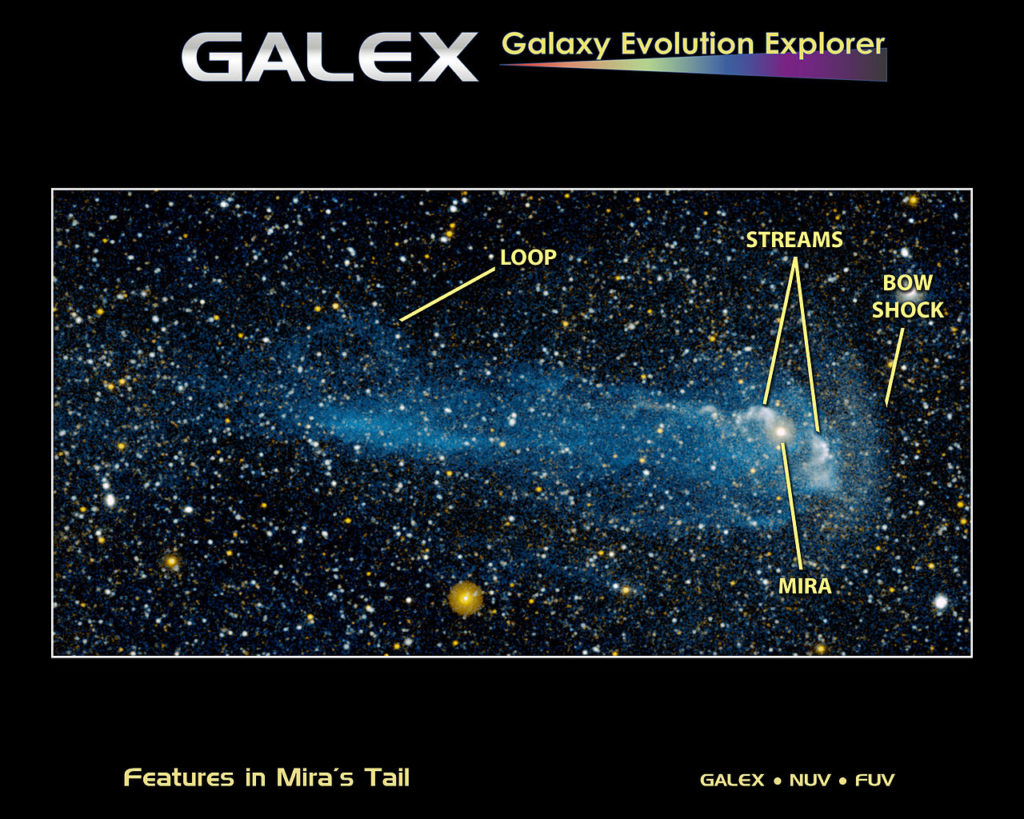
A close-up view of a star racing through space can be seen in this image from NASA’s Galaxy Evolution Explorer. The star, called Mira (pronounced My-rah), is traveling at 130 kilometers per second, or 291,000 miles per hour. As it hurls along, it sheds material that will be recycled into new stars, planets and possibly even life. In this image, Mira is moving from left to right. It is visible as the pinkish dot in the bulb shape at right. The yellow dot below is a foreground star. Mira is traveling so fast that it’s creating a bow shock, or build-up of gas, in front of it, as can be seen here at right. Like a boat traveling through water, a bow shock forms ahead of the star in the direction of its motion. Gas in the bow shock is heated and then mixes with the cool hydrogen gas in the wind that is blowing off Mira. This heated hydrogen gas then flows around behind the star, forming a wake. Why is the wake of material glowing? When the hydrogen gas is heated, it transitions into a higher-energy state, which then loses energy by emitting ultraviolet light — a process called fluorescence. The Galaxy Evolution Explorer has special instruments that can detect this ultraviolet light. Image: NASA/JPL-Caltech/C. Martin (Caltech)/M. Seibert(OCIW)
The white dwarf companion, Mira B, has the stellar classification DA, indicating a hydrogen-rich atmosphere. In 1995, Mira B was resolved by the Hubble Space Telescope. The ultraviolet images obtained with the HST and the subsequent Chandra observations showed a bridge of gas flowing from Mira to the companion.
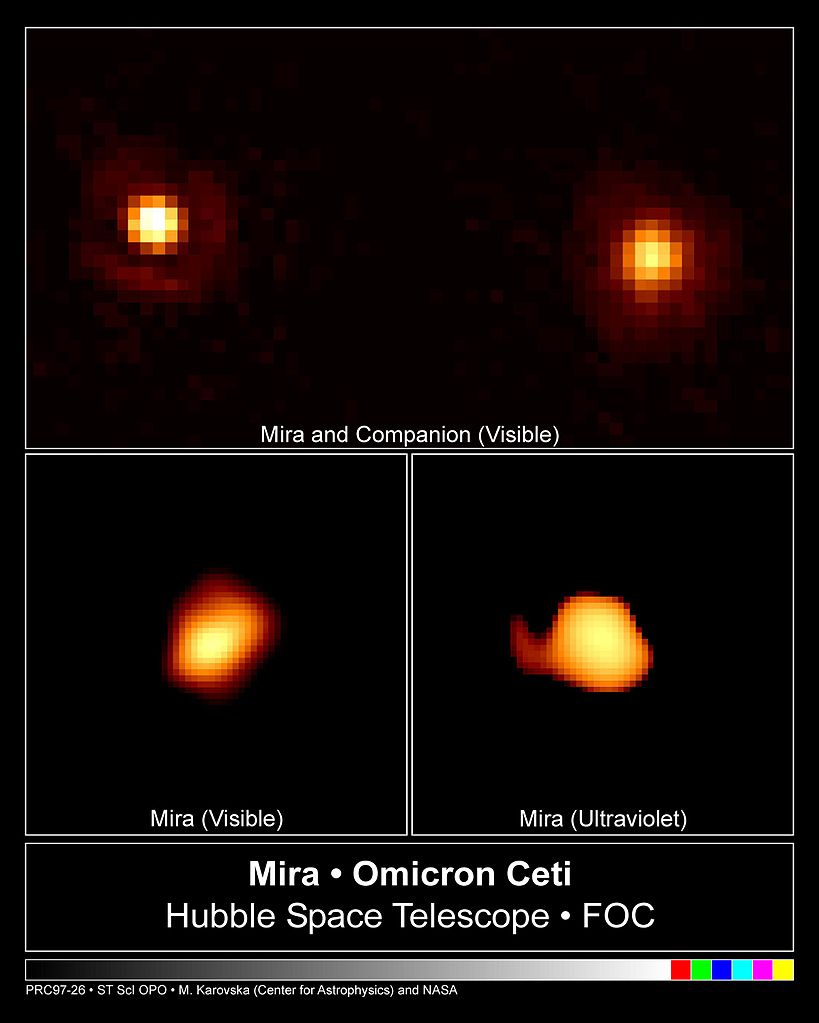
This is a NASA Hubble Space Telescope image of the cool red giant star Mira A (right), officially called Omicron Ceti in the constellation Cetus, and its nearby hot companion (left) taken on December 11, 1995 in visible light using the European Space Agency’s Faint Object Camera (FOC). The stars in this false-color picture are separated by an angular size of only 0.6 arcseconds (equal to 70 times the distance between Earth and the Sun), but clearly resolved by the FOC. Image reconstruction techniques have been used to further enhance the details in the Mira images.
In 2007, observations revealed that Mira B was surrounded by a protoplanetary disk. The accretion disk is formed of material in the solar wind of the mass-losing primary component and has a radius of about 10 astronomical units. It is a potential birthplace of new planets. The same study presented evidence that Mira B was a main sequence star with about 0.7 solar masses and not a white dwarf. However, a study published in 2010 showed that the amplitude of aperiodic optical variations (about 0.2 mag.) on timescales of minutes to tens of minutes was consistent with that of accreting white dwarfs in cataclysmic variables (close binary systems in which a white dwarf is accreting matter from the primary component) and significantly greater than that of an accreting main sequence star.
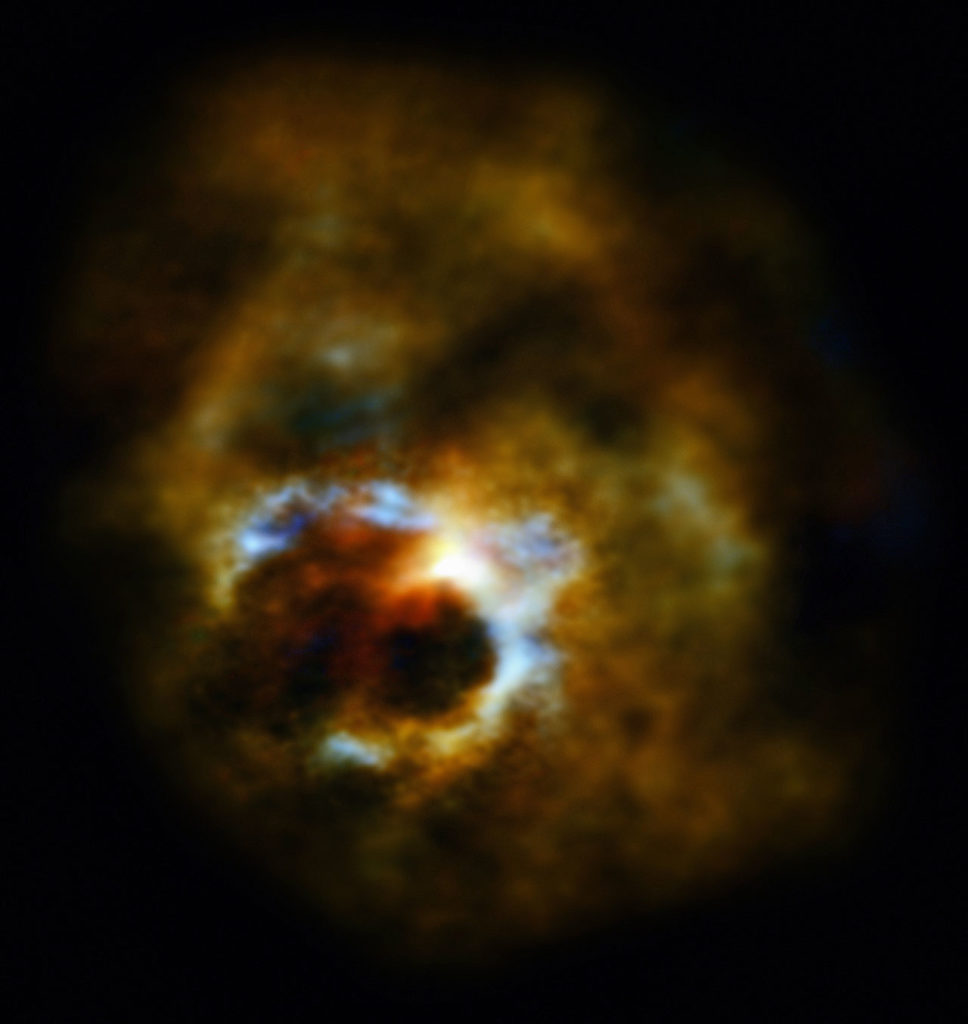
Studying red giant stars tells astronomers about the future of the Sun— and about how previous generations of stars spread the elements needed for life across the Universe. One of the most famous red giants in the sky is called Mira A, part of the binary system Mira which lies about 400 light-years from Earth. In this image ALMA reveals Mira’s secret life. Mira A is an old star, already starting to throw out the products of its life’s work into space for recycling. Mira A’s companion, known as Mira B, orbits it at twice the distance from the Sun to Neptune. Mira A is known to have a slow wind which gently moulds the surrounding material. ALMA has now confirmed that Mira’s companion is a very different kind of star, with a very different wind. Mira B is a hot, dense white dwarf with a fierce and fast stellar wind. New observations show how the winds from the two stars have created a fascinating, beautiful and complex nebula. The remarkable heart-shaped bubble at the centre is created by Mira B’s energetic wind inside Mira A’s more relaxed outflow. The heart, which formed some time in the last 400 years or so, and the rest of the gas surrounding the pair show that they have long been building this strange and beautiful environment together. By looking at stars like Mira A and Mira B scientists hope to discover how our galaxy’s double stars differ from single stars in how they give back what they have created to the Milky Way’s stellar ecosystem. Despite their distance from one another, Mira A and its companion have had a strong effect on one another and demonstrate how double stars can influence their environments and leave clues for scientists to decipher. Other old stars also have bizarre surroundings, as astronomers have seen using both ALMA and other telescopes. But it’s not always clear whether the stars are single, like the Sun, or double, like Mira. Mira A, its mysterious partner and their heart-shaped bubble are all part of this story. Image: ESO/S. Ramstedt (Uppsala University, Sweden) & W. Vlemmings (Chalmers University of Technology, Sweden)
Mira variables
Mira-type stars are long-period variables that exhibit changes in brightness with an amplitude of 2.5 magnitudes or more over a period of 100 to 1,000 days. They are red giant stars on the asymptotic giant branch (AGB) and their light curves depend on their surface temperature, radius, and opacity. These parameters vary as the stars pulsate. The pulsations enhance mass loss as the stars’ outer envelope is slowly ejected through a strong stellar wind.
Compared to stars with smaller amplitudes, Mira variables are easy to discover. By the end of the 19th century, 251 of these stars had been identified and today more than 6,000 are known. The first ones discovered after Mira were Chi Cygni (mag. 3.3 – 14.2) in 1686, R Hydrae (mag. 3.5 – 10.9) in 1704, and R Leonis (mag. 4.4 – 11.3) in 1782. Other stars of this type include R Leporis (Hind’s Crimson Star, mag. 5.5 – 11.7), R Carinae (mag. 3.9 – 10.5), S Carinae (mag. 4.5 – 9.9), R Cassiopeiae (mag. 4.4 – 13.5), R Horologii (mag. 4.7 – 14.3), and CW Leonis (mag. 10.96 – 14.80).
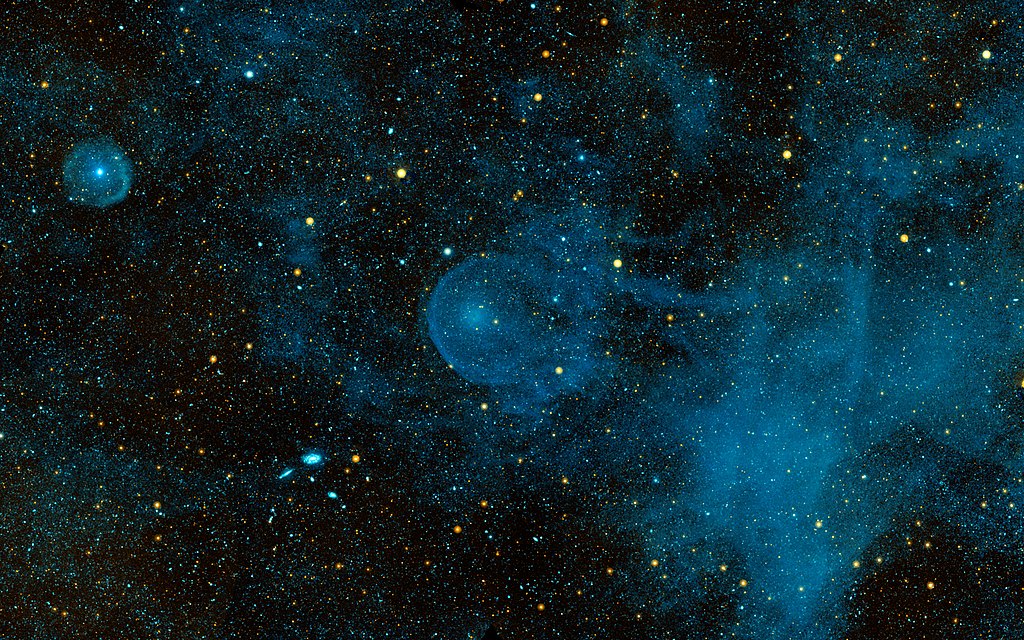
A runaway star, plowing through the depths of space and piling up interstellar material before it, can be seen in this ultraviolet image from NASA’s Galaxy Evolution Explorer. The star, called CW Leonis, is hurtling through space at about 204,000 miles per hour (91 kilometers per second), or roughly 265 times the speed of sound on Earth. It is shedding its own atmosphere to form a sooty shell of discarded material. This shell can be seen in the center of this image as a bright circular blob. CW Leonis is moving from right to left in this image. It is travelling so quickly through the surrounding material that it has formed a semi-circular bow shock in front of itself, like a boat moving through water. This bow shock is made of superheated gas, which flows around the star and is left behind in its turbulent wake. This blown-out bubble is 2.7 light-years across, which is more than half the distance from our sun to the nearest star, or 2,100 times the size of Pluto’s orbit. The size of the bubble (called the “astrosheath”) has allowed astronomers to estimate that CW Leo has been shedding its atmosphere for about 70,000 years. This is part of the star’s natural life cycle as it runs out of hydrogen fuel and gradually throws off its outer layers to expose its bare core. This core is called a white dwarf, and is the end product of all low-mass stars like our sun. CW Leo is the second runaway star to be observed with the Galaxy Evolution Explorer. The first, Mira, was observed by the telescope back in 2006. This image is the combination of near-ultraviolet data, shown in yellow, and far-ultraviolet data, shown in blue. Image: NASA/JPL-Caltech, 2012
Facts
Mira’s variable brightness was first noted by the German pastor and amateur astronomer David Fabricius, who started watching the star on August 3, 1596. Fabricius observed the planet Jupiter believing that it was Mercury and used the third-magnitude Mira as a reference star to compare positions. Several weeks later, the star became a magnitude brighter and then faded from view by October. At the time, Fabricius thought he had stumbled upon a nova. However, the star soon reappeared and he saw it again on February 16, 1609.
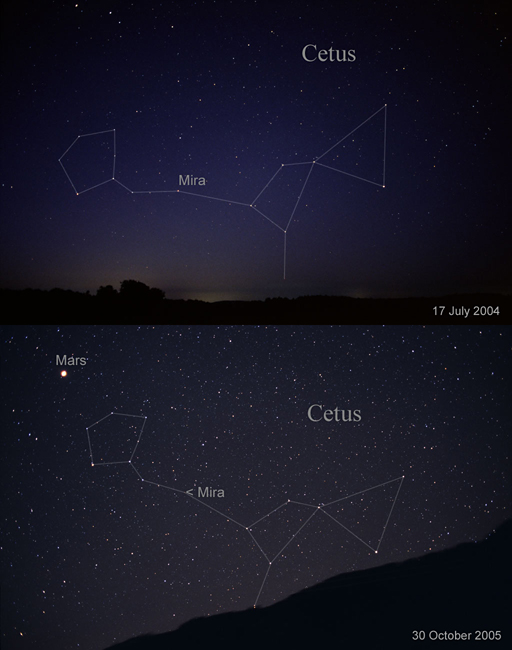
Compare the variable star Mira in the constellation of Cetus at two different times. Image: Wikimedia Commons/Till Credner (CC BY-SA 4.0)
The Dutch astronomer Johannes Holwarda is credited for the discovery of the star’s period. In 1638, he conducted a systematic study and determined the period to be 11 months, or about 330 days.
The Polish astronomer Johannes Hevelius observed Mira in roughly the same period. In 1662, he published Historiola Mirae Stellae, his first work about the star, in which he named it Mira and provided a historical ephemeris. While Holwarda’s observations were largely unknown, Hevelius put the star on the map and was more meticulous in his observations than his predecessors. He observed Mira from almost 25 years, from December 14, 1659 to August 18, 1683, but did not focus so much on the star’s periodicity as on its parallax.
The French astronomer Ismaël Boulliau determined a period of 333 days for Mira. Bouillau observed the star from March 1661 to February 1688 with a focus on its changes of phase. In 1667, he published Ad astronomos monita duo (Two warnings to astronomers), a work dedicated mainly to Mira, in which he provided the period of 333 days, about a day longer than the current value of 332 days. Bouillau’s measurement may have been accurate, as the star tends to slightly vary in period over time.
Mira was one of the first non-nova variable stars discovered. The only star that may have been discovered earlier is Algol, believed to have been mentioned in the ancient Egyptian Calendars of Lucky and Unlucky Days. The variability of Mira may have also been known to observers in ancient Babylon, China and Greece, but there is no direct evidence for it. It is, however, possible that David Fabricius was not the first to note the star’s variability. Several stars identified as Mira variables had been documented as novae in China and Korea.
Mira B was first observed visually by the American astronomer Alfred H. Joy in September 1923. At the time, it was separated by 0.9’’ from the primary. Joy studied 85 photographs of the spectrum of Mira when at minimum and announced that it was a double star. This was confirmed by Professor Aitken of the Lick Observatory a month later.
In Chinese astronomy, Mira is part of the Hay asterism (芻蒿,Chú Hāo), also formed by the stars HIP 10215, 79 Ceti, 81 Ceti, and 80 Ceti. The asterism is part of the Hairy Head mansion, which represents the body of the White Tiger.
Name
The name Mira (pronunciation: /ˈmaɪrə/) is Latin for “astonishing” or “wonderful.” It was given to the star by the Polish astronomer Johannes Hevelius in his Historiola Mirae Stellae (1662).
The name was officially approved by the International Astronomical Union’s (IAU) Working Group on Star Names (WGSN) on June 30, 2016. It formally applies only to the primary component in the Omicron Ceti system.
Mira has also been known as Stella Mira and Collum Ceti (the neck of Cetus).
Location
Mira lies in the neck of Cetus, the Whale. When it is bright enough to be seen, it can be found in the region between Menkar, the brightest star in the head of Cetus, and the fainter Baten Kaitos, which marks the belly of the mythical sea monster.
Like Baten Kaitos, Mira lies roughly along the imaginary line extended from Scheat through Algenib, two of the four stars that form the Great Square of Pegasus. Like Menkar, it has the Hyades cluster pointing in its direction. Menkar is easy to identify because it is the brightest in the circle of stars that outline the head of Cetus. The Hyades cluster is one of the brightest open star clusters in the sky, visible without binoculars on a clear night. It is easily found because it lies in the same line of sight as Aldebaran, which appears as the cluster’s brightest star even though it is in fact much closer to us. (Aldebaran is found using the stars of Orion’s Belt: Alnitak, Alnilam and Mintaka. A line extended from the Belt stars in the direction of the bright Pleiades leads directly to the star.)
Mira is invisible from late March to June to observers in mid-northern latitudes because it appears too close to the Sun. It can be seen without binoculars for about a month and a half before it reaches maximum brightness and two and a half months afterwards.
Several galaxies appear in the same area as Mira: the spiral galaxies NGC 958, NGC 955, and NGC 941, and the barred lenticular galaxy NGC 936. NGC 936 is the central galaxy in the NGC 936 Group, which is associated with the Messier 77 Group.
Constellation
Mira is located in the constellation Cetus, the Whale. Representing the sea monster that met its end at the hands of Perseus in Greek mythology, Cetus is the fourth largest of all 88 constellations, stretching across 1,231 square degrees of the sky. Like other constellations associated with figures from Greek myths, it is one of the 48 Greek constellations, first listed by the 2nd century CE astronomer Claudius Ptolemy. Cetus belongs to the Perseus family of constellations, which also includes Perseus, Andromeda, Cepheus, Cassiopeia, and Pegasus. Despite its size, Cetus is not very conspicuous because it only has two stars brighter than magnitude 3.00: the orange giant Diphda (Beta Ceti) and red giant Menkar (Alpha Ceti).
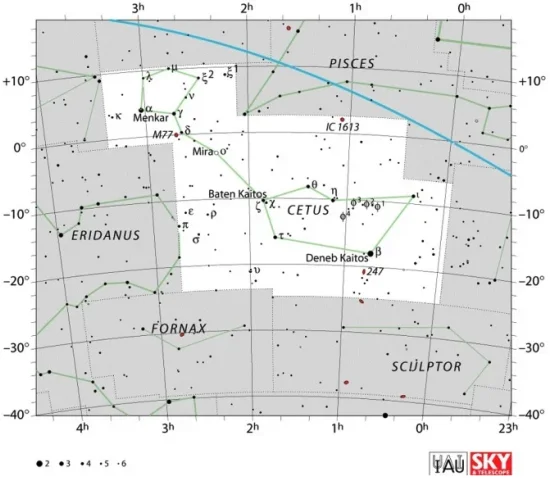
Cetus constellation map by IAU and Sky&Telescope magazine
Cetus is home to many notable stars, among them Tau Ceti, the nearest single class G star to Earth, with five candidate planets orbiting it, and the star’s nearest neighbours (3.20 light years away), UV Ceti, a prototype for a class of flare stars, and its binary companion BL Ceti, a UV Ceti-type variable. Cetus also hosts Earendel (WHL0137-LS), the most distant star discovered as of March 2022.
The constellation contains a number of bright deep sky objects. These include the barred spiral galaxy Messier 77 (Cetus A), the spiral galaxies NGC 247, NGC 1042, NGC 1035, and NGC 1055, the irregular dwarf galaxy IC 1613, and the planetary nebula NGC 246, also known as the Skull Nebula.
The best time of year to observe the stars and deep sky objects in Cetus is during the month of November.
The 10 brightest stars in Cetus are Diphda (Beta Ceti, mag. 2.02), Menkar (Alpha Ceti, mag. 2.53), Eta Ceti (mag. 3.446), Kaffaljidhma (Gamma Ceti, mag. 3.47), Tau Ceti (mag. 3.50), Iota Ceti (mag. 3.562), Theta Ceti (mag. 3.60), Baten Kaitos (Zeta Ceti, mag. 3.742), Upsilon Ceti (mag. 3.95), and Delta Ceti (mag. 4.06). Mira (Omicron Ceti, mag. 2.0 – 10.1) is sometimes among the brightest stars in the constellation and at other times it is invisible to the unaided eye.
Mira – Omicron Ceti
| Spectral class | M7 IIIe (M5e-M9e) + DA |
| Variable type | Mira variable |
| U-B colour index | +0.08 |
| B-V colour index | +1.53 |
| Apparent magnitude | 2.0 – 10.1 |
| Absolute magnitude | +0.99 (variable) |
| Distance | Cca. 300 light years (90 parsecs) |
| Parallax | 10.91 ± 1.22 mas |
| Radial velocity | +63.50 km/s |
| Proper motion | RA: +9.33 mas/yr |
| Dec.: –237.36 mas/yr | |
| Mass | 1.18 M☉ |
| Luminosity | 8,400–9,360 L☉ |
| Radius | 332 – 402 (541) R☉ |
| Temperature | 2,918 – 3,192 K |
| Age | 6 billion years |
| Constellation | Cetus |
| Right ascension | 02h 19m 20.79210s |
| Declination | –02° 58′ 39.4956″ |
| Names and designations | Mira, Collum Ceti, Omicron Ceti, ο Cet, 68 Ceti, HD 14386, HR 681, HIP 10826, GC 2796, GCRV 1301, BD−03°353, SAO 129825, PPM 184482, LTT 1179, NLTT 7657, PLX 477, GSC 04693-01144, UBV 21604, IRAS 02168-0312, 2MASS J02192081-0258393, AAVSO 0214-03, ADS 1778 AP, CCDM J02194-0258AP, TYC 4693-1144-1, WDS J02193-0259Aa,Ab, WDS J02193-0259A |
